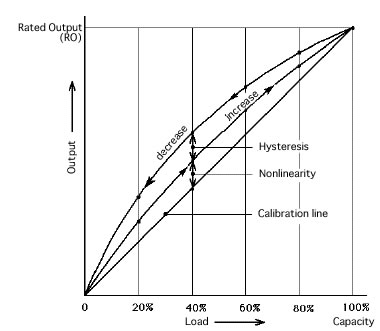Term explanation of strain gage based transducers
The terminology used for the definition of specifications of strain gage-based transducers of our manufacture is on the basis of “JIS B7602”. The graph given in the right of this description indicates errors appearing in the linearity, hysteresis and repeatability of the strain gage-based transducers and are to be understood as the maximum deflection among 5-step values against the rated output.
-

Description
Safe Overload Rating: The maximum load which can be applied without producing a permanent shift in performance characteristics beyond those specified. Normally expressed in units of %RC.
・Rated Capacity: The maximum load of the transducer which operate within its specifications.
・Rated Output: Output of the transducer. Normally expressed in units of mV/V.
・Nonlinearity: The maximum devitation between output at increasing load and the corresponding point on the straight line drawn between no load and capacity load. Normally expressed in units of %RO.
・Hysteresis: The maximum devitation between output at decreasing load and the corresponding point on the straight line drawn between no load and capacity load. Normally expressed in units of %RO.
・Repeatability: The maximum devitation of output for the same load under the same conditions. Normally expressed in units of %RO (average of rated output).
・Recommended Excitation Voltage: The maximum exitation voltage of the transducer which operate within its specifications.
Safe Excitation Voltage: The maximum exitation voltage of the transducer which can be applied without producing a permanent change.
・Input Rsistance: The resistance of the transducer circuit measured at the excitation terminals with no load applied and with the output terminals open-circuited.
・Output Resistance: The resistance of the transducer circuit measured at the signal terminals with no load applied and with the excitation terminals open-circuited.
・Compensation Temperature Range: The range of temperature over which the transducer is compensated to maintain output and zero balance within specified limits.
・Safe Temperature Range: The extremes of ambient temperature within which the transducer will operate without permanent adverse change to any of its performance characteristics.
・Temperature Characteristic on Zero Balance: The change in zero balance due to a change in ambient temperature. Normally expressed in amount of change per 1 degree Celsius at percentage of the rating output (%RO/℃).
・Temperature Characteristic on Output: The change in output due to a change in ambient temperature. Normally expressed in rate of change per 1 degree Celsius (%/℃).
・Natural Freqency: The frequency of free oscillations under conditions of no load.
・Weight: The weight only for the main body except the cable.
